|
| |
Back to light
transports
 |
Piper produced their first low-wing aircraft
with the twin engined Piper PA23 Apache, a design they acquired from
the Stinson company. It is a four-seater with a range of 1,200 miles
and a cruising speed of 190 mph. This made it similar to, but slower
than, the directly competing Cessna 310, which flew a year later
than the Apache's March 1952. It was made in large numbers.
A very early 1955 Apache is pictured at
Stapleford in December 2004. |
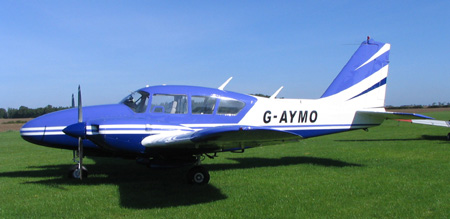 |
The Piper PA27 Aztec is often, confusingly,
designated PA-23, like the Apache from which it is derived. The
Aztec is a six seater, first flown in 1959, designed to extend the
functionality of the Apache by becoming an excellent load-carrier:
its maximum payload is 2,270 lb. It became the standard six-seater
air taxi aircraft through the 1960s and 1970s until replaced by the
Seneca (see below). The US Army operated several under the
designation U-11. This Aztec was
pictured on a superb day visiting Top Farm in September 2005. |
 |
The Piper PA30 Twin Comanche was first flown
in November 1962. It is literally a twin engined version of the
PA-24 Comanche. It is essentially the replacement for the Apache but
optimised for speed & range. It normally seats six people. An
unusual version, designated PA-39, has the propellers rotating in
opposite directions to reduce torque.
This standard PA30 visited Newcastle in April 1976. |
|
|
The Piper PA31 Navajo is the largest aircraft
in the Piper range. Seating up to 8, with a top speed of 260mph and
range of 1,500 miles, it is a very practical executive or light
commuter aircraft competing with the Beech Duke and the larger
Cessna twins. The top picture is a PA31P (illustrated, at Toussus in June 1979) is a pressurised version which can cruise at
up to 24,000 feet. It is normally distinguished by having fewer
windows than its unpressurised counterpart.
The lower picture is a Navajo Chieftain, seen at
Le Touquet in September 2005. |
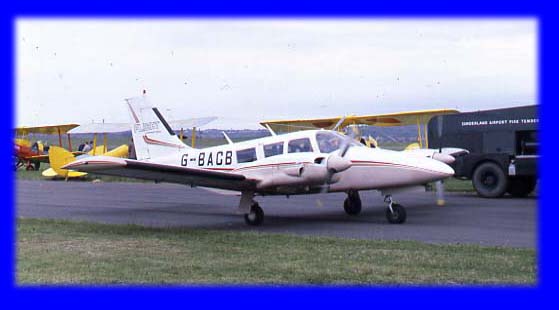 |
The Piper PA34 Seneca first flew in 1971. It
is basically a PA32 Cherokee Six with two engines on the wing
replacing the PA32's single engine. It has acceptable
performance in all three main areas (payload, range, speed) without
being stellar at any of them. But it has one overwhelming advantage:
it doesn't cost much. That made it instantly popular and, despite
its lower payload, it soon became the de facto replacement for the
Aztec. This one visited Sunderland while
acting as the photo aircraft for the De Havilland Moth Club rally in
1979. |
 |
The Piper PA44 Seminole is probably the most
successful of the set of light four seat twins developed in the
1970s. It first flew in May 1976, the intention being to replace the
Twin Comanche. It was based on the fuselage of the PA28R Cherokee
Arrow, including the T tail layout of the Arrow IV. Its two 180hp
Lycoming O-360 engines give it a cruising speed of 175mph and range
of 1,000 miles. It is 27 feet 7 inches long, with a wing span of 38
feet 8 inches and gross weight of 3,800lb. About 672 have been built
- it is still in low rate production in early 2006.
This one was at White Waltham, July 2005 |
 |
The Aero Design Company was formed after the
war to make a series of stylish twin engined executive transports.
Cruising at 220mph, with a range of 1,200 miles, seating for up to
nine people plus a crew of two, it competes with the Piper Navajo
and the bigger Cessna twins. It is quite expensive, despite which
several hundred were made in several versions. The company was taken
over by Rockwell in the 1970s. Some were operated by the USAF with
the designations U-4 and U-9. This Rockwell Commander 500
was seen at Newcastle in the mid 1970s. |
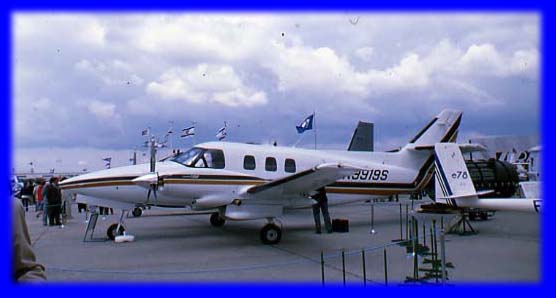 |
The Rockwell Commander 700 was an odd design
for the Rockwell corporation, being a low-wing rather than a
high-wing twin. It was luxuriously appointed as a high specification
executive aircraft, intended for people who would like a Beech
Kingair but couldn't quite afford one. Despite being a very good
aircraft, it entered a crowded market just at the point where the
world economy tipped into recession in the early 1980s, and as a
result very few were sold. This one (the
17th built) was at Paris - Le Bourget in 1983. |
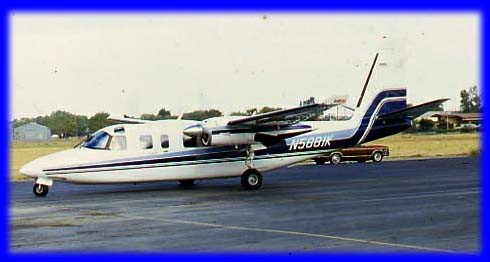 |
The Rockwell Commander 840 was a turboprop
version of the successful Commander series (see above). Having
turbine engines and pressurisation gave it a speed of 285mph at
15,000 feet, but the higher fuel burn restricted the range to 1,000
miles. Nevertheless it was a practical competitor to the Beech
Kingair in the corporate transport market.
This Commander 840 was at Los Banos in
California in September 1981. |
 |
The Swearingen Merlin was originally intended
to be a major update of the Beech Queenair, but designer Ed
Swearingen quickly evolved it into an entirely separate aircraft. It
seats ten people plus two crew, and is powered by two Garrett TPE331
turboprop engines. With a range of 2,300 miles it is a highly
capable executive aircraft. It has been
operated by many air forces but, oddly, not the USAF. Illustrated is
a Merlin III of the Belgian air force, seen at Greenham Common in
June 1979. |
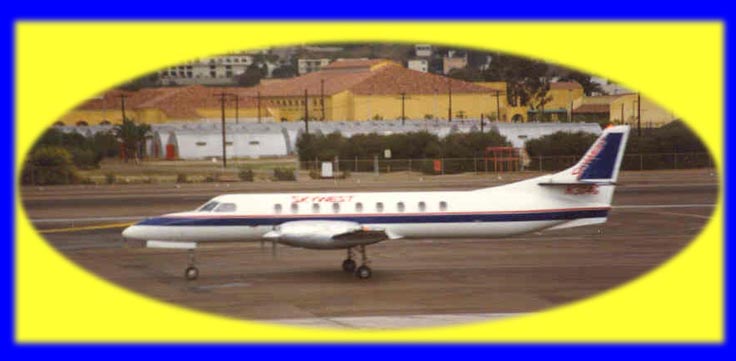 |
The Swearingen Metro was a very stretched
modification of the Metro, intended as a commuter airliner for up to
20 passengers plus two crew. It is widely used, especially in the
USA, to ferry people from small regional airports into larger
airports as part of a `hub and spoke' network feeding longer-haul
carriers: hence the term `feederliner' which was coined to describe
the type. The USAF has operated some under the designation C-26. The
design was taken over by Fairchild in the 1980s.
This rather poor picture of a Metro was taken at
San Diego in 1988. |
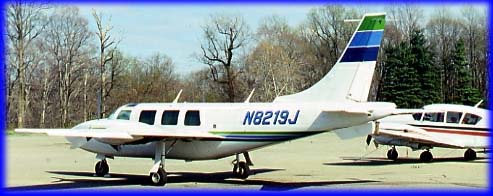 |
The Ted Smith Aerostar is one of the most
extraordinary of the light twins. Ted Smith was the chief designer
of Aero Commander, and was responsible for their range of high-wing
twins. He set up his own company to produce this six seat design. In
its final form, it achieved a crunchy 280mph cruising speed with
piston engines. This was at the expense of range; to achieve the
maximum range of 1,350 miles meant reducing the speed to 220mph.
1,000 were built, half of them by Piper, before production ceased in
1985. This Aerostar was seen at the
Flying W ranch airport in April 1988. |





|